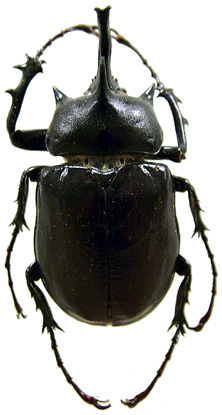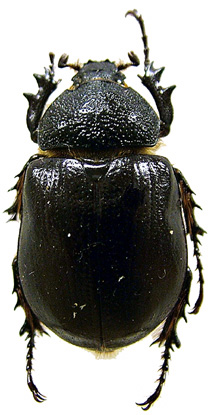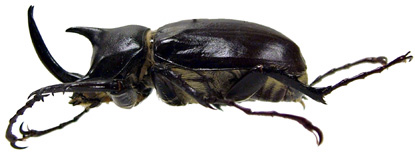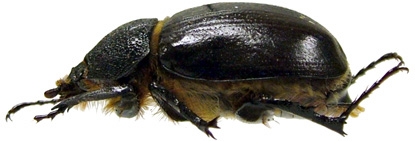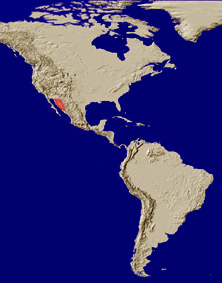 |
|||||||
|
|||||||
|
||
|
|
||
| Dynastinae Taxa Map | ||
| Dynastini key | ||
| Pentodontini key | ||
| Megasoma key | ||
| Megasoma gallery |
male, dorsal view
female, dorsal view
male, lateral view
female, lateral view
Photos by Matthew R. Moore
Distribution: Mexico (Sonora and Sinaloa) (Cartwright 1963; Gibson 1964).
Diagnosis: Both sexes with elytra and pronotum glabous. Males with anterioly directed mid-thoracic horn. Females with pronotum punctate. Anterior margins of clypeus with acute, spiniform teeth. Fronotclypeal suture with tubercle on flat surface. Ocular canthus subtriangular with length medially 1.5-2.0 times larger than length distally. Ocular canthus with anterior margin strongly oblique (45º angle from perpendicular). Elytral punctation near base with sparse, small punctures mixed with moderately dense, moderately large punctures.
Biological Data: Adults of M. pachecoi are found in deciduous, tropical forests at elevations between 100 and 500 m (Gibson 1964). During the day adults feed on the cambium and waxy secretions of “palo brea” (Cercidium torreyanum [Wats.] Sarg., Caesalpinaceae), and “huacaporo” (Parkinsonia aculeata L., Caesalpinaceae) (Gibson 1964). Males will often engage in combat, pushing and shoving with their head armature until one male leaves the site (Ratcliffe 2005). Gibson (1964) found that copulation took at least 15 minutes, and females oviposit into galleries of rotten wood and soil immediately afterwards. Eclosion takes place after 30-40 days depending on when the eggs were laid. Larvae have a short development of 10 months, or a long development of at least 2 years. Adults are crepuscular and are attracted to lights (Gibson 1964).
Temporal Distribution: August-October (Ratcliffe 2005).
Larvae: Ratcliffe and Morón (2005) described the first and third instar larvae.
References:
Cartwright, O.L. 1963. Two new species of Megasoma from the United States and Mexico (Coleoptera: Scarabaeidae). Coleopterists Bulletin 17: 25-29.
Gibson, W. W. 1964. Observations on the biology of Megasoma pachecoi Cartwright (Coleoptera: Scarabaeidae) from northwest Mexico. Folia Entomológica Mexicana 7-8: 38-39.
Ratcliffe, B.C. and M.A. Morón. 2005. Larval descriptions of eight species of Megasoma Kirby (Coleoptera: Scarabaeidae: Dynastinae) with a key for identification and notes on biology. Coleopterists Bulletin 59: 91-126.
|
||||
|
|
